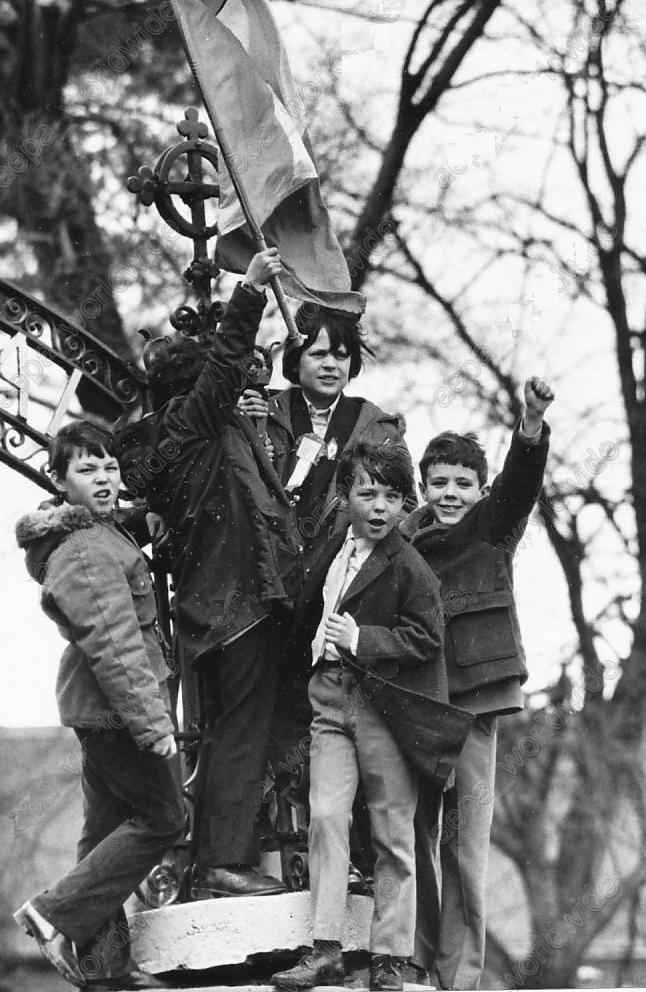
The Ulster Troubles: Escalation of Violence (1970-72)

Figure 1.--This 1972 press photo was captioned, "The Tragic Routine of Belfast: A Republican parade was held in Belfast on Easter Sunday; and this group of youngsters got into the act with their own flag-waving celebration." Source: Camera Press (G/M) London. The intensity of feeling on the boys' faces reflects what was going on all around them. I think the flag is the Irish flag.
|
|
The Battle of the Bogside led to 3 years of escalating violence. The violence peaked with nearly 500n people killed (1972). There were attacks on British soldiers and British operations agaimnst the IRA, but more than half of those killed were civilains. This was the worst year of the violence. There were several reasons for the escalating violence. Many Catholics were outraged on the violence unleased against their communities and they wee disappointed in the IRA for its inability or unwillingness to defend them. This is probably at the hear of the escalating violence. Authors have various interpretations. Unionists thend to believe that the formation of the Provisional Irish Republican Army was at the heart of the problem. Nationalists tend to believe that the escalation of violence was a result of the frustration when the hopes of the civil rights movement were not only frustrated, but their communities attacked in the Battle of the Bogside. Subsequent security measures were not well received in part because they seemned more doirected at Catholics and Protestants. The Government imposed a curfew on the highly nationalist Lower Falls area of Belfast (July 1970). They deployed 3,000 trops to enforce the Falls Curfew. The troops reportedly fired 1,500 rounds in the urban residential community in running gun battles with the IRA. Four people were killed. Another action deeply resented by Catholics. The Government to stop the violence introduction internment of suspected terrorists without trial (1971). More than 350 detainees were initially detained. What alienated Catholics was not only the measure, but no Protestants were detained. [Walker, p. 27.] As with many of these issues, they can get very complicated, but the number of detaineees and their religious orientatioin is a matter of fact. Preventitive tetention is a highly controversial subjects which is hotly debated. Some argue that faulty intelligence led to the arrest of many people not involved in violence. [Bonner, p. 89.] Some argue that the experience led many to become Republicans activists. This may be the case, but is difficult to prove. Overall, the Government detained 1,981 people (1,874 were Catholics, 107 were Protestants). Nationalists charged that the detainees were abused and even tortured. A particularly inflamatoty incident was Bloody Sunday in which British Army troops shot 14 people (January 1972). Nationsalist charge that they were peaceful, unarmed civil rights demonstrators in Derry.
Sources
Bonner, David. Executive Measures, Terrorism and National Security: Have the Rules of the Game Changed? (Ashgate, 2007).
Walker, R. K. The Hunger Strikes (Lagan Books, 2006).
HBC

Navigate the Boys' Historical Clothing Web Site:
[Return to Main Ulster Tropubles page]
[Return to Main Ulster page]
[Return to Main 20th Century War page]
[Introduction]
[Activities]
[Biographies]
[Chronology]
[Clothing styles]
[Countries]
[Bibliographies]
[Contributions]
[FAQs]
[Glossaries]
[Images]
[Links]
[Registration]
[Tools]
[Boys' Clothing Home]
Created: 6:55 AM 7/18/2009
Last updated: 6:55 AM 7/18/2009



